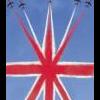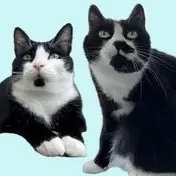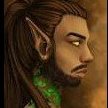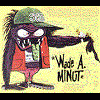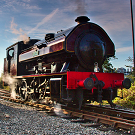-
Posts
1,103 -
Joined
-
Last visited
-
Days Won
3
Tail-Dragon last won the day on December 2 2022
Tail-Dragon had the most liked content!
About Tail-Dragon
- Birthday 23/10/1954
Profile Information
-
Gender
Male
-
Location
Winnipeg, Manitoba, Canada
-
Interests
W.W.2 Aviation, Armour, Naval and Helo's
Tail-Dragon's Achievements

Very Obsessed Member (5/9)
5.2k
Reputation
-
From what I've read, the early intakes were circular, and later ones were enlarged and oval shaped.
-
This is the Tamiya 1/48 P-51D Mustang, marked as John C. Meyer's "Petie 2nd". Typical of Tamiya, easy assembly and a nice fit. The only weak points are the wheel well not going back to the spar, and a prop that is too wide and tapered at the cuff (easy to correct). I used an Ultracast seat, and the sliding canopy is a spare from an Airfix kit (suitably reshaped). Wheel well was opened to the aft spar, brake lines added, and the radio, battery and drop tanks wired, and plumbed. Decals are the kits (works well with VERY hot water), and the paints are all Tamiya acrylic. Thanks for looking, Colin
-
This is the early ICM (Tamiya knockoff) 1/48 P-51D Mustang, marked as "Miss Marilyn II". As and early ICM kit, there were a number of challenges, HUGE sink marks, short shots, incorrect detail parts copied from other kits, and a canopy that looked like it had been removed from the mold with a shovel! I used an Ultracast seat, and the sliding canopy is a spare from an Airfix kit (suitably reshaped). The front windscreen is from a scrapped Monogram P-51, that had to be reshaped, shortened, and polished to fit. Wheel well was opened to the aft spar, brake lines added, and the radio, battery and drop tanks wired, and plumbed. Decals are ancient Superscale (that tried to shatter on contact with water - to the point that some codes were masked and sprayed), and the paints are all Tamiya acrylic. Thanks for looking, Colin
-

Miss Marilyn II, 1/48 P-51D Mustang
Tail-Dragon replied to Tail-Dragon's topic in Work in Progress - Aircraft
Finally got around to completing "Miss Marilyn II", more photo's on RFI -

RAF Color Help Brown and Green for a Hurricane Mk1
Tail-Dragon replied to Tokyo Raider's topic in Aircraft WWII
Yes, the darker (lower) colors are under a coat of Future. Note, they do lighten up with a flat coats. -
FalkeEins started following Tail-Dragon
-
I did one a few years ago and attempted to replicate the scheme as closely as possible, referencing all the available photos. (Note: spinner mottle has since been changed to sandy brown mottle on yellow) ... big problem (other than the lack of truly accurate decals) is that there are no photos that clearly show the upper and lower surface of the wings. Thats where guesswork comes in.
-

Lysander Target tug project
Tail-Dragon replied to Tail-Dragon's topic in Work in Progress - Aircraft
Slats fit to wing well now (not permanently attached yet) ... flaps next! -

Lysander Target tug project
Tail-Dragon replied to Tail-Dragon's topic in Work in Progress - Aircraft
The slat/flap work is progressing, flaps were separated and fronts built up and profiled with plasticard. Slat wells were scraped down (wing thickness was enough to allow this) and slats thinned and shaped to fit. Wings can now be assembled and slat tracks made. -

Academy 1/48 Sikorsky CH-53E Super Stallion
Tail-Dragon replied to Jon Bryon's topic in Ready for Inspection - Aircraft
That is an absolute masterpiece! Congratulations. -

Lysander Target tug project
Tail-Dragon replied to Tail-Dragon's topic in Work in Progress - Aircraft
Small update today, added the Canadian specific right side step found on the target tugs (brass wire and sprue ... ... and decided to use the leading edges from a junked Testors Lysander as the basis for the slats - reqiures thinning and a bit of reshaping, but the tapered airfoil shape is bang on. Much easier than trying to form them myself. The Gavia wing plastic should be thick enough to scrape down to form the slat well. -

Lysander Target tug project
Tail-Dragon replied to Tail-Dragon's topic in Work in Progress - Aircraft
Thanks, I already have that masking set, it will make the markings a lot easier. -

Lysander Target tug project
Tail-Dragon replied to Tail-Dragon's topic in Work in Progress - Aircraft
I've got some color on the interior now, and am ready to close the fuselage, after all the work on the winch assembly, very little can be seen! The gunsight mount above the panel is made from various diameters of stretched sprue ... ... the exhaust collector will start out a bright metalic, and will be darkened and discolored later ... -
I have a couple of Monogram Kingfishers that I was doing interiors for, based on all the drawings and info I could find. (currently on the 'waiting for inspiration' pile). They might help ... https://www.britmodeller.com/forums/index.php?/topic/235123093-148-os2u-3-kingfisher/
-

Lysander Target tug project
Tail-Dragon replied to Tail-Dragon's topic in Work in Progress - Aircraft
I'm continuing the Lysander cockpit work (adding cockpit details, RCAF style radios, winch details), but have finished the work on the engine, prop, and landing gear. The big challenge will be the dropped slats and flaps, I'm still experimenting with different ideas. Painting is next, so I can bring the fuselage, gear, and engine together, and the look at the wings. -
Somewhere in the distant past, I read that there were 2 different horizontal stab spans - between the M2 and M3 test aircraft, the stab was extended for stability reasons.


